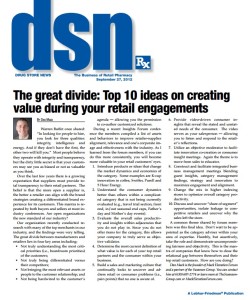The great divide: Top 10 ideas on creating value during your retail engagements.
Warren Buffet once shared: “In looking for people to hire, you look for three qualities: integrity, intelligence and energy. And if they don’t have the first, the other two will kill you.” Most people believe they operate with integrity and transparency, but the dirty little secret is that your customers may see you as biased or not as valuable as you think.
Over the last few years there is a growing expectation that suppliers must provide total transparency to their retail partners. The belief is that the more open a supplier is, the better a retailer can align with the brand strategies creating a differentiated brand experience for its customers. This mantra is repeated by both buyers and sellers at most industry conferences. Are open organizations the new standard of our industry?
Our organization recently conducted research with many of the top merchants in our industry, and the findings were very telling. The great divide between manufacturers and retailers lies in four key areas including:
• Not truly understanding the most critical priorities (i.e., boardroom priorities) of the customers;
• Not truly being differentiated versus their competitors;
• Not bringing the most relevant assets or people to the customer relationship; and
• Not being hardwired to the customer’s agenda — allowing you the permission to co-author customized solutions.
During a recent Insights Forum conference the members compiled a list of assets and behaviors to improve retailer-supplier alignment, relevance and one’s corporate image and effectiveness with the industry. As I learned from the forum members, if you can do this more consistently, you will become more valuable in your retail customers’ eyes.
1. Introduce products or ideas that change the market dynamics and economics of the category. Some examples are K-cup innovation in coffee, Swiffer, Purell and 5 Hour Energy.
2. Understand the consumer dynamics better than others within a complicated category that is not being currently evaluated (e.g., travel trial section, front end, in/out seasonal end caps, Father’s day and Mother’s day events).
3. Evaluate the overall sales productivity and insights within adjacencies that you do not play in. Since you do not offer items for the category, this allows your company to truly serve as objective validator.
4. Determine the most current definition of what value is for each of your top retail partners and the consumer within your business.
5. Build a sales and marketing culture that continually looks to uncover and address retail or consumer problems (i.e., pain points) that no one is aware of.
6. Provide video-driven consumer insights that reveal the stated and unstated needs of the consumer. The video serves as your salesperson — allowing you to listen and respond to the retailer’s reflections.
7. Utilize an objective moderator to facilitate innovation co-creation or consumer insight meetings. Again the theme is to move from sales to educator.
8. Construct and facilitate integrated business management meetings blending guest insights, category management findings, strategy and innovation to maximize engagement and alignment.
9. Change the mix in higher indexing stores to optimize overall category productivity.
10. Discuss and uncover “share of segment” opportunities, isolate leakage to competitive retailers and uncover why the sales left the store. A common theme shared by forum members was this final idea. Don’t wait to be appointed as the category adviser within your area of expertise. Humbly, but assertively, take the role and demonstrate uncompromising fairness and objectivity. This is the mantra of companies that know how to close the relational gap between themselves and their top retail customers. How are you doing?[/vc_column_text][/vc_column][/vc_row]


